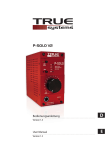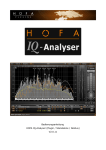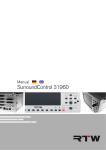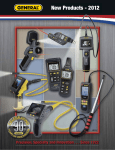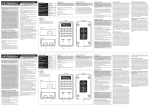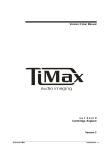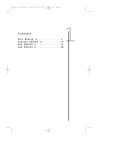Download P2A Bedienungsanleitung
Transcript
TRUE systems TM P2 analog Bedienungsanleitung D Version 1.2 User Manual Version 1.1 E P2analog TRUE systems P2analog Vielen Dank für das Vertrauen, das Sie uns mit dem Kauf des P2analog entgegengebracht haben. Der P2analog wurde entwickelt, um auch bei den anspruchsvollsten Aufnahmen ein detailliertes und transparentes Klangbild zu liefern. Die perfekte Kombination aus hochwertiger Technik und praxisgerechter Ausstattung macht den P2analog zum optimalen Partner für Aufnahmen aller Art. Vorwort Einleitung Bitte scheuen Sie sich nicht, uns mit Ihren Fragen oder Anregungen zu kontaktieren. Wir freuen uns immer von Ihnen und Ihren erfolgreichen Produktionen zu hören. In Anlehnung an unsere viel gefeierten TRUE Solo Preamps, bietet der P2analog zwei Instrument Direct Inputs (DI), die ein Klangbild liefern, das bis dato nur von High-End DI-Boxen bekannt war. Diese Eingänge ermöglichen unglaubliche Präsenz und Kontrolle für Bässe und Gitarren, Detailtreue und Wärme für Streicher und Pianos. Durch die hohe Eingangsimpedanz können Sie sogar den optimalen Sound aus Ihren vintage Instrumenten herausholen! Überblick Auch im Zeitalter der großen Audio-Workstations und Software Plugins bleibt die Plazierung von Mikrofonen ein kritischer Faktor, der das gesamte Klangbild maßgeblich beeinflußt. Die umfangreiche Ausstattung des P2analog unterstützt Sie dabei, bei praktisch jeder Stereo-Aufnahme, das Optimum an Qualität zu erreichen. Eine dieser Funktionen ist der integrierte M/S Dekoder, der eine detaillierte Kontrolle des Raumklangs ermöglicht. Mit einem minimalen Arbeitsaufwand bei der Mikrofonierung erhalten Sie ein beeindruckendes Stereo-Bild, das Sie zudem noch kreativ verändern können. Die M/S Technologie findet Ihren Einsatz in einer Vielzahl von Anwendungen, bei Raumklang in der Klassik, Overhead-Mikrofonie bei Schlagzeugaufnahmen bis hin zu Gesang und akustischen Instrumenten – wann auch immer eine akkurate Abbildung der Klangquelle und ihrer Räumlichkeit gewünscht ist. Die M/S Mikrofonie verhindert auch den „Loch-in-der-Mitte-Effekt“. Und ganz egal, ob Sie M/S, XY oder eine andere Stereo-Mikrofonie-Technik anwenden, die Korrelationsgrad-Anzeige im P2analog wird Ihnen bei der Positionierung der Mikrofone für ein perfektes Stereo-Bild ein große Hilfe sein. D Zusätzlich zu den eben genannten Funktionen bietet der P2analog : • Dual Gain Bereiche zur Anpassung an die unterschiedliche Empfindlichkeit von Mikrofonen • Zuschaltbarer High-Pass Filter (40 Hz & 80 Hz), um Atem- und Windgeräusche zu minimieren • Relais-gesteuertes Signalrouting für einen möglichst unverfälschten Signalweg • Phasenumkehrschalter zur Korrektur von Polaritätsfehlern durch falsche Positionierung der Mikrofone oder Probleme bei der Verkabelung von XLR und Stereo-Klinke (TRS) Anschlüssen • Phantomspeisung (48V) TRUE systems Sicherheitshinweise P2analog Wichtige Sicherheitshinweise ACHTUNG! Hochspannung Gefahr durch Stromschlag Das Gerät nicht öffnen. Im Inneren befinden sich keine vom Benutzer reparierbaren Teile. Reparaturarbeiten dürfen nur von qualifiziertem Fachpersonal durchgeführt werden. Netzanschluss Bevor Sie das Gerät mit dem Stromnetz verbinden, überprüfen Sie bitte sorgfältig, ob die richtige Versorgungsspannung eingestellt ist. • • • • • Verwenden Sie nur Sicherungen vom gleichen Typ und gleichen Kenndaten. Das Gerät muss geerdet sein. Defekte Anschlussleitungen nicht verwenden. Schließen Sie keine Ausgänge von Verstärkern an das Gerät an. Betreiben Sie das Gerät nur in Übereinstimmung mit der Bedienungsanleitung. Feuchtigkeit Um eine Gefährdung durch Feuer oder Stromschlag auszuschließen, darf dieses Gerät weder Regen noch Feuchtigkeit ausgesetzt werden. Auch Spritzwasser oder tropfende Flüssigkeiten dürfen nicht in das Gerät gelangen. Stellen Sie keine Gefäße mit Flüssigkeiten, z. B. Getränke oder Vasen, auf das Gerät. Wenn das Gerät von einem kalten an einen warmen Ort gebracht wird, kann sich im Inneren Kondensationsfeuchtigkeit bilden. Erst einschalten, wenn sich das Gerät auf Raumtemperatur erwärmt hat. Montage Oberflächen des Gerätes können im Betrieb heiß werden. Sorgen Sie für ausreichende Luftzirkulation. Vermeiden Sie direkte Sonneneinstrahlung und die unmittelbare Nähe zu Heizkörpern, Heizstrahlern und ähnlichen Wärmequellen. Sorgen Sie beim Einbau in ein Rack für ausreichende Luftzufuhr und montieren Sie das Gerät nicht direkt über/unter einer Endstufe. Lüftungsöffnungen nicht abdecken. Bei Fremdeingriffen in das Gerät erlischt die Garantie. Betreiben Sie das Gerät nur in Übereinstimmung mit der Bedienungsanleitung. Verwenden Sie nur vom Hersteller spezifiziertes Zubehör. Lesen Sie die Bedienungsanleitung vollständig. Sie finden dort alle Informationen, die Sie zum Einsatz des Gerätes benötigen. TRUE systems P2analog Inhaltsverzeichnis Vorwort 3 Sicherheitshinweise 4 Inbetriebnahme Auspacken Aufstellen Schnellstart DI Input MS-Decoder Anschlüsse Rückseite 5-6 7 8-9 Bedienungselemente Vorderseite 10 - 11 M/S Technik Details Korrelationsgrad-Anzeige 12 - 13 Fehlersuche 14 - 15 Zum Thema Kabel ... Technische Daten 16 Rechtliches 17 D TRUE systems INBETRIEBNAHME Auspacken P2analog Bitte prüfen Sie den P2analog nach dem Auspacken auf eventuelle Transportschäden. Für den Fall, dass Sie sichtbare Schäden feststellen, dürfen Sie das Gerät auf keinen Fall an die Stromversorgung anschließen. Wenden Sie sich dann bitte umgehend an Ihren Händler. Lieferumfang: • P2analog • Netzkabel (IEC) • Bedienungsanleitung • Infoblatt zu Garantie und Registrierung Wie empfehlen Ihnen, die komplette Verpackung für einen späteren Versand aufzubewahren. So vermeiden Sie Transportschäden. Verwenden Sie für einen eventuellen Rücktransport auf keinen Fall „Verpackung-Chips“ oder ähnliches Verpackungsmaterial. Im Laufe des Transports rüttelt sich das Gerät bis zum Boden durch und es kann zu Schäden kommen! Wenn die originale Verpackung nicht mehr zur Verfügen steht, verwenden Sie am besten eine Luftpolsterfolie, in die Sie das Gerät großzügig einwickeln. Das Ganze packen Sie dann zusätzlich in einen stabilen Karton. Aufstellen Stellen Sie den P2analog immer auf eine stabile Unterlage. Wenn Sie das Gerät im Rack montieren, verwenden Sie bitte nur das vom Hersteller/ Händler empfohlene Zubehör. Ist das Gerät im Rack dauerhaften Schwingungen ausgesetzt, sollten Sie das Gehäuse des P2analog seitlich oder hinten abstützen. Beachten Sie bitte auch folgendes: • Setzen Sie das Gerät keinem Regen oder Feuchtigkeit aus. • Setzen Sie das Gerät nicht extremen Temperaturen aus. • Stellen Sie das Gerät nicht in der Nähe von starken elektrischen oder magnetischen Feldern auf. • Achten Sie bei Rackmontage auf ausreichende Belüftung. Eventuell lassen Sie zwischen den Geräten einige Zentimeter frei. Anschließen Bevor Sie das Gerät mit dem Stromnetz verbinden, überprüfen Sie bitte sorgfältig, ob die richtige Netzspannung eingestellt ist! (Siehe Seite 8) Beachten Sie die Sicherheitshinweise auf Seite 4. TRUE systems P2analog SCHNELLSTART 1. Lesen Sie die Sicherheitshinweise auf Seite 4. 2. Prüfen Sie, ob der Spannungswahlschalter auf die Netzspannung Ihrer Region eingestellt ist. . Vergewissern Sie sich, dass der Netzschalter auf „OFF“ steht bevor sie das Netzkabel anschließen. 4. Verbinden Sie die Line Outputs des P2analog mit den Line Inputs Ihres Recorders, Mischpultes oder Ihrer DAW (Digital Audio Workstation) etc. (siehe „Anschlüsse“). . Verbinden Sie Ihre symmetrischen Mikrofone mit XLR Mikrofonkabeln mit den MIC Inputs des P2analog . . Schalten Sie das Gerät ein (Netzschalter auf „ON“). . Aktivieren Sie die Phantomspeisung und/oder 180° Phasenumkerschaltung - falls nötig oder gewünscht. 8. Pegeln Sie die Mikrofone über die Gain Regler und LED Anzeigen ein und überprüfen Sie die Phasenlage Ihres Stereo-Signals anhand der Korrelationsgradanzeige. Wenn’s schnell gehen soll 1. Verbinden Sie Ihr Instrumentenkabel mit der DI1 oder DI2 Buchse auf der Vorderseite des P2analog . Der MIC Input wird bei Verwendung des DI Inputs automatisch abgeschalten, sobald ein Instrumentenkabel in die DI Buchse eingesteckt wird. HINWEIS: Verwenden Sie keine symmetrischen Kabel mit StereoKlinken-Stecker. Der DI-Eingang funktioniert sonst nicht korrekt. 2. Aktivieren Sie 180° Phasenumschaltung, falls gewünscht. . Erhöhen Sie den Pegel über den jeweiligen Gain Regler und kontrollieren Sie die Aussteuerung über die LED Anzeige. Ein Instrument anschließen 1. Verbinden Sie das Mitten-Mikrofon mit Nieren- oder KugelCharakteristik mit dem MIC 1 Input. 2. Verbinden Sie das Seiten-Mikrofon mit Achter-Charakteristik (∞) mit dem MIC 2 Input. Richten Sie das Seiten-Mikrofon auf die linke Seite der Schallquelle im rechten Winkel zur Mitten-Achse aus (siehe Bild). . Aktivieren Sie über den MS Schalter den M/S Modus. Das ‚Links’ Signal wird zu Kanal 1 Output und das ‚Rechts’ Signal zu Kanal 2 Output geroutet. 4. Pegeln Sie Kanal 1 über den Gain Regler 1 ein. . Pegeln Sie Kanal 2 über den Gain Regler 2, bis die gewünschte Stereo-Breite der Schallquelle erreicht wird. . Mehr über M/S Technik auf den Seiten 12-13. Der M/S Dekoder im Einsatz TRUE systems D MID SIDE P2analog ANSCHLÜSSE CAUTION LINK RISK OF ELECTRIC SHOCK DO NOT OPEN ATTENTION RISQUE DE CHOC ELECTRIQUE - NE PAS OVRIR 115/230 V 50/60 Hz, 22W 2 BALANCED ANALOG OUTS OUT 2 OUT 2 OUT 1 MIC 2 MIC 1 PIN 2 + PIN 3 - OUT 1 SUNRISE ENGINEERING AND DESIGN INC. TUCSON, ARIZONA U.S.A. For continued protection against fire replace only with same type fuse: 115 T 315 mA L , 250V 230 T 160 mA L , 250V 1 This device complies with Part 15 of the FCC Rules. Operation is subject to the following two conditions: (1) this device may not cause harmful interference, and (2) this device must accept any interference that may cause undesired operation. TRUE Systems - P2analog 3 4 MS 5 6 Signalerdung (Ground Link) 1 Der Signal Ground-LINK verbindet die Signal-Masse mit der Erdung des Netzanschlusses. Bei Bedarf entfernen Sie die Verbindung. Weitere Infos im Bereich „Fehlersuche“. Spannungswahl 2 Bevor Sie das Netzkabel anschließen, prüfen Sie bitte, ob die für Ihr Land passende Netzspannung eingestellt ist. Netzbuchse 3 Zum Anschluß eines IEC-Netzkabels mit genormtem Euro-Stecker Sicherungshalter 4 Entsprechend der Einstellung am Spannungs-Wahlschalter 2 115V 100-132 VAC • 60 Hz T 315 mA, 250 V 230V 200-264 VAC • 50 Hz T 160 mA, 250 V ACHTUNG: Verwenden Sie nur die oben genannten Sicherungen nach IEC 60127-2! Ausgang • Line Signal 5 Für die einfache Verkabelung mit nachfolgenden Geräten steht der symmetrische LINE-Ausgang in zwei verschiedenen Anschlüssen zur Verfügung: Als XLR-Buchse und als Stereo-Klinken-Buchse. Beide sind elektronisch identisch aufgebaut und können gleichzeitig verwendet werden. Achten Sie dabei auf Brummschleifen (siehe auch Fehlersuche auf Seite 15). Beide Ausgänge sind nicht elektronisch getrennt. Wenn also einer davon unsymmetrisch angeschlossen ist, wird auch der andere Ausgang automatisch unsymmetrisch geschaltet. Die Signalbelegung der Ausgänge am P2analog ist wie folgt: XLR: Stereo-Klinkenbuchse: Pin 2 > positiv (+) Spitze > positiv (+) Pin 3 > negativ (-) Ring > negativ (-) Pin 1 > Abschirmung (Masse) Gehäuse > Abschirmung (Masse) TRUE systems P2analog Zum Anschluss der Mikrofone befinden sich zwei standard XLR-Buchsen auf der Rückseite des P2analog. Unterhalb der MIC 1 und MIC 2 Buchse finden Sie die jeweilige Bezeichnung für den M/S Betrieb des P2analog . MIC 1 ist dabei der Eingang für das Mitten- und MIC 2 der Eingang für das Seiten-Signal. (siehe M/S Technik 12-13) • Pin 2 > positiv (+) • Pin 3 > negativ (-) • Pin 1 > Abschirmung (Masse) ANSCHLÜSSE 6 Eingang • Mikrofon Versuchen Sie nicht, unsymmetrische Mikrofone an den P2analog anzuschließen. Dafür ist der P2analog nicht ausgelegt. HINWEIS: Wenn Sie die Mikrofoneingänge des P2analog über ein Steckfeld (Patchbay) verkabelt haben und das Mikrofonsignal wechseln, schalten Sie unbedingt vorher die Phantomspeisung aus und drehen die Verstärkung auf ein Minimum. So vermeiden Sie Schäden an den Geräten - und an Ihren Ohren! Viele Anwender des P2analog haben eine Menge Zeit und Geld in die Auswahl des richtigen Mikrofons und den passenden Vorverstärker investiert. Bitte berücksichtigen Sie aber auch die Qualität der Verbindungskabel. Zum Thema Kabel ... • Verwenden Sie nur hochwertige Kabel mit geringer Kapazität. Mikrofonkabel mit einem Schirmgeflecht und 4 Innenleitern (Quad) sind unempfindlicher gegenüber Störungen. Hersteller wie Canare, Mogami und andere bieten solch hochwertige Kabel an. • HINWEIS: Manche „Hausmarken“ werden von renommierten Herstellern gefertigt, andere widerum können sehr schlecht sein. • Verwenden Sie nur Kabel mit hochwertigen Steckverbindern (Neutrik, Switchcraft etc.). • Tests im Studio haben gezeigt, dass die doch etwas „esoterischen“ Instrumenten-Super-Kabel tatsächlich auch besser klingen. Ein hörbarer Unterschied, aber für einen höheren Preis. Probieren Sie es einfach selber, aus bevor Sie solch ein Kabel kaufen. • Vermeiden Sie überlange Kabel. • Ersetzen Sie beschädigte Kabel und Stecker. D Für die optimale Verkabelung Des P2analog empfehlen wir Ihnen das STUDIO-Referenz-Kabel von MOGAMI. Ein Kabel mit hervorragenden technischen Eigenschaften, bester Impulsübertragung, detailliert und transparent. Durch den Aufbau mit 4 Innenleitern (Quad) ist es auch sehr unempfindlich gegenüber Störungen. TRUE systems P2analog BEDIENELEMENTE 1 2 DI-1 DI-2 DI Input Eingang • Instrument 1 80HZ 180 o TRUE systems 3 40HZ HPF GAIN 48V 4 5 SIG +4 +12 +15 +18 +21 +24 OL 1 6 MID SIDE 7 Über den Instrument-Eingang (DI) können Sie Instrumente mit Tonabnehmern oder unsymmetrische Quellen wie Synthesizer und Keyboards anschließen. Dieser Eingang wurde so entwickelt, dass der P2analog qualitativ den besten DI-Boxen gleichwertig, wenn nicht sogar überlegen ist. Der Mikrofon-Eingang wird bei der Benutzung des InstrumentEingangs automatisch abgeschaltet. Alle Bedienelemente des P2analog stehen auch für den Instrumenten-Eingang zur Verfügung, nur die Parameter verändern sich: Verstärkungsbereich -4 dB bis +44 dB (Gain Schalter -4- ist „ON“) und -16 bis +32 dB (Gain Schalter -4- ist „OFF“). Hinweis: Verwenden Sie keine symmetrischen Kabel mit Stereo-KlinkenStecker. Der Eingang funktioniert sonst nicht korrekt. Empfehlungen für den Betrieb der DI Inputs: • Der HPF 3 kann in einigen Fällen für nützliche und interessante Klangänderungen verwendet werden. • Sollten Sie ein Instrument mit zwei Instrument Outputs besitzen, versuchen Sie den M/S-Modus für weitere Klangvariationen. • Wie viele Gitarristen wissen, erzeugen einige Pickup-Systeme nur bei gewissen Impedanzen den optimalen Sound. Um klangliche Einbußen zu vermeiden, ist die Impedanz des DI Inputs mit 2,5 MOhm sehr hoch. Durch die hohe Eingangsimpedanz können Sie sogar den optimalen Sound aus Ihren vintage Instrumenten herausholen! 10 Phase Reverse Phasenumkehrschalter 2 Mit diesem Schalter können Sie die Phasenlage des Eingangssignals um 180° drehen. Verwenden Sie die Umkehrung der Polarität, um Phasenfehler bei der Positionierung der Mikrofone oder unterschiedlicher Verkabelung auszugleichen. HPF (High Pass Filter) Bass-Filter 3 Aktivieren Sie den HPF, um unerwünschte tieffrequente Störungen wie Windgeräusche oder Bühnen- und Trittschall zu reduzieren. Es können zwei unterschiedliche Frequenzen (40 Hz und 80 Hz) angewählt werden. Die gewählte Frequenz wird über LEDs angezeigt, leuchtet keine, ist der Bass-Filter außer Betrieb. HINWEIS: Der HPF des P2analog ersetzt NICHT den Popp-Schutz bei Nahbesprechung der Mikrofone. TRUE systems P2analog 8 10 BEDIENELEMENTE 11 STEREO PHASE CORRELATION I M-S P2 0 90 180 0 ON/OFF 2-channel microphone preamplifier a n a lo g 9 Mit dem Gain Range Schalter kann der gewünschte Verstärkungsbereich des P2analog angewählt werden. Der Schalter kann wie ein normaler ‚Pad’ verwendet werden - jedoch ohne klangliche Einbußen wie bei herkömmlichen ‚Pad’ Schaltung. Der Verstärkungsbereich der MikrofonEingänge beträgt 15,5 dB bis 64 dB bei aktivierten Gain Range Selector (LED leuchtet) und 3,5 dB bis 52 dB bei Low Gain (LED leichtet nicht). 4 Gain Range Selector Verstärkungswahl Die für den Betrieb von Kondensator-Mikrofonen benötigte Phantomspeisung (48 V DC) wird über den 48V Schalter aktiviert (LED leuchtet). Schalten Sie die Phantomspannung aus, wenn Sie mit Bändchenmikrofonen arbeiten. Hierfür verwenden Sie am besten unseren P-Solo Ribbon Preamp. Bei der Verwendung dynamischer Mikrofone oder des DI Inputs empfiehlt es sich ebenfalls, die Phantomspeisung zu deaktivieren (LED leuchtet nicht). 5 Phantom Power Phantomspeisung Mit diesem Regler stellen Sie die passende Verstärkung ein. Im Normalbetrieb haben Sie hier den Bereich von 15,5 dB bis 64 dB zur Verfügung. Siehe auch unter 4 6 Gain Control Verstärkungsregler Nutzen Sie die LED Anzeige, um den Signalpegel für nachfolgende Geräte optimal einzustellen und eine Übersteuerung des Preamps zu vermeiden. • Die ‚SIG’ LED zeigt ein anliegendes Signal an und leuchtet, sobald das anliegende Signal einen Pegel von -24 dBu erreicht. • Die LEDs +4 bis +24 leuchten bei den jeweiligen Pegel auf. • Die OL-LED signalisiert einen Signalpegel von +26 dBu, dies entspricht 5 dBu unter dem Maximalpegel (+31 dBu) des P2analog*. 7 Pegelanzeige HINWEIS: Einige Audio-Geräte können den hohen Ausgangspegel des P2analog nicht verarbeiten. Es kommt zu Übersteuerungen, obwohl die Overload-LED am P2analog noch nicht aufleuchtet. In einem solchen Fall sollten Sie nur auf einen Maximalpegel von +4 oder +12 aussteuern. Optional können Sie auch die als Zubehör erhältlichen Pegeladapter verwenden. * Der maximale Ausgangspegel im INP ATTEN Modus ist +27 dBu. D 8 M/S Schalter 9 Korrelationsanzeige Näheres dazu auf Seite 12-13 10 Anzeige ON/OFF Mit dem Netzschalter trennen Sie den P2analog vom Stromnetz. 11 Netzschalter TRUE systems 11 M/S TECHNIK M/S Schalter P2analog 8 Wenn Sie den M/S Modus aktivieren (LED leuchtet), ändert sich die Belegung der Kanäle: Das Signal an Eingang 1 (Mikrofon mit Niere- oder Kugel-Charakteristik) wird in “Mono” auf Ausgang 1 und 2 ausgegeben. Das Signal an Eingang 2 (Mikrofon mit Achter-Charakteristik) wird zum einen “normal” auf Ausgang 1 ausgegeben und “phasengedreht” auf Ausgang 2. Damit regeln Sie also den die Stereo-Basisbreite. Ausgang 1 wird dabei zu “Links” und Ausgang 2 zu “Rechts” Hinweis: Im M/S-Modus werden in beiden Kanälen die Funktionen “Gain” und “Phase” auf normal gesetzt. Zudem sind die beiden “Gain”-Schalter miteinander verbunden. Drücken sie einen, wird auch der andere Kanal umgeschaltet. Phase Meter ON/OFF Korrelationsanzeige 10 Die Korrelationsgradanzeige kann mit diesem Schalter deaktiviert werden. Für den Fall, dass diese Anzeige sehr hektisch arbeitet und dadurch in ruhiger Umgebung stört. M/S-Technik im Detail (Mid/Side Decoding) Die M/S-Technik ist eine besonders kreative Funktion des P2analog. Obwohl diese Technik schon sehr lange bekannt ist, waren die Möglichkeiten sie einzusetzen oftmals begrenzt. Schuld daran waren fehlende Spezialmikrofone bzw. verfügbare Dekoder. MID SIDE 12 Was genau ist die M/S-Technik? Es ist eine Stereo-Mikrofonierung mit zwei unterschiedlichen Mikrofonen. Eins mit Kugel- oder Nierencharakteristik für das Mono-MittenSignal, und ein Mikrofon mit Achter-Charakteristik, ausgerichtet 90º zur Schallquelle (siehe Bild). Die Signale der beiden Mikrofone werden über die M/S Decoding Matrix des P2analog in Abhängigkeit ihrer Phasen- und Lautstärkenverhältnisse gemischt und über die Ausgänge als L/R Stereo Signal wiedergegeben. Der Vorteil von M/S gegenüber der typischen XY-Technik? Ursprünglich wurde die M/S Technik benutzt, weil sie ein mono-kompatibles Stereo-Signal liefert. Da dies für heutige CD Produktionen kaum mehr von Bedeutung ist, findet die M/S Technik vorwiegend im Rundfunk und beim Filmton ihren Einsatz. Es gibt aber noch einen ganz besonderen Vorteil der M/S-Technik: Durch eine Pegeländerung des Seiten-Signals bei gleichbleibendem Pegel des Mitten-Signals wird eine Veränderung der Stereo-Breite bewirkt. Es ist also nicht nötig, die Position der Mikrofone zu verändern, um die Stereo-Basisbreite einer Schallquelle variieren zu können. Der M/S Modus des P2analog bietet höchste tonale Qualität und optimale Räumlichkeit bei minimalem Aufwand bei der Positionierung der Mikrofone. TRUE systems P2analog M/S TECHNIK Wann wird M/S Technik eingesetzt ? Immer, wenn Mono-Kompatibilität eine wichtige Rolle spielt und bei Schallquellen, die ihre Klangcharakteristik im Raumklang entwickeln. So zum Beispiel: • Orchester und Chor • Overheads beim Schlagzeug • Backup Gesang und Gruppen mit akustischen Instrumenten • Solo-Instrumente und Gesang in akustisch guten Räumen • Rundfunk • Filmton und Geräusche • TV- und Video-Produktion (Anpassung von Bild und Stereo-Breite des Tons) Die Korrelationsgradanzeige des P2analog analysiert und vergleicht die Phasen-Information der beiden Ausgänge und zeigt über die Anzeige die Phasentreue des Stereo Signals an (siehe Bilder). Die Korrelationsgradanzeige hilft Ihnen bereits bei der Positionierung der Mikrofone um unerwünschte Phasenprobleme wie den ‚Kammfilter Effekt’ zu vermeiden. Wenn Sie ein gutes Stereo-Bild wünschen, richten Sie die Mikrofone so aus, dass die LED Kette der Korrelationsanzeige hauptsächlich den mittleren Bereich (gelber Bereich) anzeigt. Bei komplexen Schallquellen kann die Korrelationsgradanzeige stellenweise etwas hektisch arbeiten. In diesen Fällen kann die Anzeige über den Phase Meter ON/OFF Schalter deaktiviert werden. • • • • Die Korrelationsgradanzeige ist nicht zu verwechseln mit einer Pegelanzeige. Wenn dort die rote LED leuchtet, ist das meistens gleichbedeutend mit einer Übersteuerung (Verzerrung). Bei der Korrelationsanzeige von zwei Signalen ist ein zeitweises Aufleuchten der roten LEDs ein Indiz für eine gute Stereo-Basis-Breite. Mit einer „nur grün“ Anzeige sind Sie zwar auf der sicheren Seite, ein gutes Stereo-Signal erreichen Sie damit aber nicht. Die Korrelationsgradanzeige ist für den Einsatz mit einer Stereo-Aufstellung der Mikrofone gedacht. Für die Aufnahme mit zwei unabhängigen Mikrofone ist die Anzeige nicht aussagekräftig. Diese Anzeige ist ein gutes Hilfsmittel zum Einrichten der Mikrofone, die letzte Referenz sollte aber immer Ihre Ohren sein. 9 Anzeige Beispiele Beide Signale sind phasengleich = mono STEREO PHASE CORRELATION 0 90 180 Hier ein Beispiel für ein normales Stereo-Signal STEREO PHASE CORRELATION 0 90 180 Beide Kanäle haben große Unterschiede in der Phasenlage und produzieren ungewollte tonale Variationen und abfallende Höhen STEREO PHASE CORRELATION 0 90 180 > justieren Sie die Position der Mikrofone zueinander. Beide Kanäle sind zueinander komplett phasenSTEREO PHASE CORRELATION 0 90 180 gedreht. > Aktivieren Sie für einen Kanal den “180°” Phasenumkehrschalter. TRUE systems 13 D P2analog FEHLERSUCHE Problem Lösung Kein Ausgangssignal Der Netzschalter ist an, es leuchten aber keine LEDs. • Prüfen Sie den Netzanschluss • Prüfen Sie die Netzsicherungen (Vorher unbedingt Netzkabel ziehen!) Kein Ausgangssignal Der Netzschalter ist an, einige LEDs leuchten. • Benötigt das Mikrofon Phantomspeisung? 48V aktivieren • Kontrollieren Sie die Kabel für die Ein- und Ausgänge Verzerrtes Ausgangssignal Der Ausgang ist symmetrisch angeschlossen.. • Die OL- Anzeige sollte während des normal Audio-Programms nicht aufleuchten > Verstärkung zurücknehmen • Prüfen Sie ob das nachfolgende Gerät nicht übersteuert wird > Verstärkung zurücknehmen oder Pegelreduzierglied am Ausgang anschließen • Kontrollieren Sie die Verbindungskabel • Überprüfen Sie die Eingangsimpedanz des nachfolgenden Gerätes. Sie muß höher als 600 Ohm sein Verzerrtes Ausgangssignal Der Ausgang ist unsymmetrisch angeschlossen. • Überprüfen Sie ob der Ausgang richtig verkabelt ist > Pin 3 muß mit Pin 1 verbunden sein (siehe auch Seite 9) • Kontrollieren Sie die Pegel des Ausgangssignals Das Signal von Eingang 1 ist im Ausgang 2 zu hören und umgekehrt • Prüfen Sie den M/S-Schalter. Für unabhängige Kanäle sollte dieser Schalter auf “OFF” stehen. Aktivieren Sie den M/S-Modus nur, wenn Sie auch mit dieser Technik arbeiten möchten. Eingang 2 bringt kein Signal an den Ausgängen In der Stereo-Aufstellung mit Eingang 1 • Prüfen Sie den M/S-Schalter. Für Stereo-Aufnahmen sollte der Schalter auf “ON” stehen. Beide Phasen-Schalter sollten auf “OFF” stehen Im M/S-Modus sind die Kanäle vertauscht. Eingang 1 ist rechts und Eingan 2 ist links • Im M/S-Modus ist die Phasenlage nicht richtig. • 14 TRUE systems • • Kontrollieren Sie ob das Mikrofon für die Seitenkanäle mit 90º zur Schallquelle aufgestellt ist. Schalten Sie zum Überprüfen den Phasen-Schalter im Eingang 2 zeitweise auf 180º. Beide Eingänge sollten die gleiche Einstellung bei den Phasen-Schaltern haben. P2analog FEHLERSUCHE • Prüfen Sie die Kabelverbindungen. • Kontrollieren Sie die Batterien der angeschlossen Geräte • Stellen Sie sicher, dass nur unsymmetrische Kabel verwendet werden > benutzen Sie keine stereo Klinken-Stecker Der Instrument-Eingang funktioniert gar nicht oder ist verzerrt. • Prüfen Sie die Kabel, insbesondere die Abschirmung. • Trennen Sie die Masse-Verbindung (Pin 1) auf der Empfängerseite des Verbindungskabels auf. Brummen ist zu hören. • Verwenden Sie nur hochwertige Kabel. • Prüfen Sie die Abschirmung der Kabel. • Kontrollieren Sie die Schutzerdung am Netzkabel. Kleben Sie die Erdung nicht ab! • Stellen Sie sicher, dass keine Geräte die Radiofrequenzen abstrahlen, in der Nähe sind (Handy, Walky-Talk u. ä.). Radio-Störungen sind im Hinertgrund zu hören. D TRUE systems 15 P2analog Technische Daten Frequenzgang Verzerrungen (THD) +26 dBu @ 100 kOhm Verstärkung • Mikrofon (Dual Range) Verstärkung • Instrument 0,008 % 3,5 bis 52 dB alt. 15,5 bis 64 dB -16 bis 32 dB alt. -4 bis 44 dB Rauschen Rs = 0 Ohm -132 dB e.i.n. Anstiegszeit > 40 V/µs Gleichtaktunterdrückung CMV = -10 dBu 85 dB Max. Eingangspegel +15 dBu (+25 dBu @ Input ATTEN) Max. Ausgangspegel +31 dBu (+27 dBu @ Input ATTEN) Eingangsimpedanz Mikrofon 5,5 kOhm Eingangsimpedanz Instrument 2,5 MOhm Ausgangsimpedanz Stromversorgung Leistungsaufnahme Abmessungen Gewicht 16 1,5 Hz bis 500 kHz (-3dB) 100 Ohm Internes Netzteil (60 W) Umschaltbar: 110 VAC 60 Hz 220 VAC 50 Hz 22 W Höhe: 45 mm, Breite: 445 mm, Tiefe: 350 mm 6,8 kg (ohne Verpackung) TRUE systems P2analog Jedes Gerät von TRUEsystems wird einzeln geprüft und einer vollständigen Funktionskontrolle unterzogen. Die Verwendung ausschließlich hochwertigster Bauteile erlaubt die Gewährung von zwei Jahren Garantie. Als Garantienachweis dient der Kaufbeleg / Quittung. Die Produkt-Registrierung erfolgt online auf www.synthax.de. Schäden, die durch unsachgemäßen Einbau oder unsachgemäße Behandlung entstanden sind, unterliegen nicht der Garantie und sind daher bei Beseitigung kostenpflichtig. Schadenersatzansprüche jeglicher Art, insbesondere von Folgeschäden, sind ausgeschlossen. Eine Haftung über den Warenwert des Gerätes hinaus ist ausgeschlossen. Es gelten die Allgemeinen Geschäftsbedingungen der Firma Synthax GmbH. Synthax GmbH Am Pfanderling 60 D-85778 Haimhausen Garantie Garantie Registrierung Fon: +49 (0) 8133-91810 Fax: +49 (0) 8133-918119 Email: [email protected] Wir: Sunrise Engineering and Design Inc. 1634 S. Research Loop, Suite 150, Tucson, Arizona 85710, USA CE-Konformität erklären in alleiniger Verantwortung, dass das hier beschriebene Gerät mit den folgenden Normen und Richtlinien übereinstimmt: • 73/23/EWG Niederspannungsrichtlinie • 89/336/EWG Elektromagnetische Verträglichkeit (EMV) • EN 60065 Sicherheit von Audio-Geräten • DIN EN 55103-1/2 Störaussendung und Störfestigkeit von Audio-Geräten Tucson, 14.2.2007 Tim Spencer, Geschäftsführer Bei einer nicht von uns genehmigten Änderung des Gerätes verliert diese Erklärung ihre Gültigkeit. Das Produkt wurde konform zur Richtlinie 2002/95/EC gefertigt. RoHS-Konformität RoHS compliant 2002/95/EC Nach dem Elektro- und Elektronikgesetz (ElektroG) sind Besitzer von Altgeräten gesetzlich gehalten, das Altgerät getrennt vom Hausmüll zu entsorgen. Helfen Sie bitte mit und leisten einen Beitrag zum Umweltschutz. Weitere Informationen zur Entsorgung dieses Gerätes erhalten Sie beim nächstgelegenen Wertstoffhof. Altgeräteentsorgung Um höchste Audioqualität zu gewährleisten, werden die Geräte von TRUE systems immer dem aktuellen Stand der Technik angepasst. Erforderliche Änderungen in Konstruktion und Schaltung werden ohne Ankündigung vorgenommen. Technische Daten und Erscheinungsbild können daher von der vorliegenden Bedienungsanleitung abweichen. Stand der Technik Alle in dieser Anleitung verwendeten Warenzeichen und eingetragenen Marken sind Eigentum der jeweiligen Inhaber. Warenzeichen Diese Anleitung ist urheberrechtlich geschützt. Jede Vervielfältigung bzw. jeder Nachdruck, auch auszugsweise, ist nur mit schriftlicher Genehmigung der Firma Synthax GmbH gestattet. Dies gilt auch für die verwendeten Bilder und Grafiken. Urheberrecht TRUE systems D 17 TRUE systems TM P2 analog User Manual Version 1.1 E P2analog 20 TRUE systems P2analog Introduction The P2analog is designed to provide the detailed, transparent sonic performance necessary for the most critical direct tracking and live sound applications. It includes a unique combination of functions that make it useful as a complete input system for standalone or PC-based recording systems. And, the P2analog has special features that provide the serious musician or recordist with useful tools to get the best sound more quickly and easily. We appreciate the confidence you have placed in TRUE Systems by purchasing this product. Please feel free to contact us with questions or comments. And, we always appreciate hearing about successful projects you have completed. INTRODUCTION In addition to our acclaimed TRUE preamps, P2analog features two instrument direct inputs (DI’s) that offer sonic performance previously thought to be available only with dedicated, highend DI’s. You’ll get incredible articulation and control for electric bass, detail and smoothness for stringed instruments and keyboards. And, there’s even an impedance modification option to help you get the most out of your vintage Strat! Even with today’s emphasis on powerful digital audio platforms and software plugins. To perform signal processing tasks, the issue of microphone placement remains a critical variable in determining the quality of your final sonic product. The P2analog incorporates powerful features that assist you in achieving optimum microphone placement for nearly any stereo recording situation. One of these features is a selectable MS (MidSide) decoder which provides creative spatial control that is useful in attaining an exciting stereo image with minimum effort and microphone repositioning. The MS microphone technique can be employed effectively in a wide variety of circumstances, from classical ensemble, to drum kit overheads, to solo vocal or instrument – whenever accurate capture of the performance and its acoustical space is desired. MS micing also eliminates the “hole-inthe-middle” effect. And, whether using MS, XY or other stereo mic techniques, our Stereo Phase Correlation Display can assist in positioning the microphones for a rich stereo image. In addition to the previously mentioned features, the P2analog includes: • Dual Gain Ranges to accommodate a wide range of microphone sensitivities • Selectable HighPass Filters to minimize breath and wind noise • Relay Signal Switching to provide the cleanest possible signal path • Polarity Reverse to correct polarity inversions caused by mic position or cable wiring variations • XLR and TRS output connectors for easy connectivity • Phantom Power (48V) OVERVIEW TRUE systems E 21 Safety Instruction P2analog Important safety instructions: DANGER! High Voltage Risk of electrical shock Do not open chassis. No user serviceable parts inside. Refer service to qualified service personnel only. Mains: Before connecting the device to the main power supply, please check if the right voltage is selected. • • • • Only replace fuse with the same type and value This device must be earthed Do not use a damaged power cord Never connect the output of a power amplifier to this device Humidity: To reduce the risk of fire or electric shock do not expose this device to rain or moisture. Never place containers with liquid onto the unit. Do not use this product near water, e. g. swimming pool, bathtub or wet basement. If this device is moved from a cold place to a warm room condensation can occur inside the unit. To avoid damaging the unit please allow it to reach room temperature before switching on. Installation: Surfaces of the unit may become hot, always allow enough ventilation space around the unit for air circulation. Do not install this device near any heat source such as radiators, stoves or other heat sources. Do not cover circulation vents. Only use accessories that are specified by the manufacturer. Read the entire manual. There you´ll find all the information you need for using this device. 22 TRUE systems P2analog Table of contents Introduction 21 Safety Instruction 22 Installation Unpacking Mounting 24 Up an Running In a Hurry DI Input MS-Decoder 25 Connectors Back Panel 26 - 27 Controls Front Panel 28 - 29 M/S Details Details Correlation Meter 30 - 31 Troubleshooting 31 - 32 A word about cables ... Technical Data 32 Legal 33 E TRUE systems 23 P2analog Starting up INSTALLATION Unpacking and Inspection We recommend that you inspect your P2analog upon unpacking it from the factory shipping carton. In the unlikely event that the unit exhibits any physical damage, DO NOT connect it to the AC mains power, but contact your dealer immediately. In addition to the P2analog , the shipping carton should also include: • AC power cord • Operation Manual • Warranty registration sheet We recommend that you keep the shipping carton and foam supports in the event that the unit must be shipped at some time in the future. DO NOT package the unit in “packing peanuts” or similar material as it will settle during shipping and damage will likely occur. If original packing materials cannot be located, wrap the unit with a liberal amount of plastic “bubble wrap” material extending at least 2” beyond the extremities of the P2analog enclosure. Mounting The P2analog is designed for conventional rack mounting, or standalone mounting by use of the adhesive rubber feet supplied. Avoid locating the unit next to equipment that emits strong electromagnetic fields. If the unit is to be permanently mounted in a high vibration environment, you may wish to provide additional side or rear support to prevent possible distortion of the mounting ears. • Do not locate the unit where it is exposed to rain, moisture, or liquid spills. • Do not locate the unit where it is exposed to temperature extremes. Ventilation We recommend that you provide adequate ventilation so that the air temperature surrounding the unit does not exceed 55°C (122°F). If multiple units are to be mounted in a poorly ventilated rack or travel case, a 1 3/4” blank space should be located after every three units (three units mounted together, blank space, three more units, etc.). PSU-P8i PRECISION 8i 24 TRUE systems P2analog Up and Running 1. Read the “SAFETY and OPERATING PRECAUTIONS”on page 22 of this manual. 2. Check the voltage selector on the rear panel to make sure it is set for the appropriate AC mains voltage in your area. 3. After making sure the main power switch is off, connect the AC power cord. 4. Connect output signal cables between P2analog and the analog line level inputs of your recorder, mixer, signal processor, etc. Use either the 1/4” TRS or XLR balanced output connectors. See the section “Connections” for wiring details. 5. Connect mic cables to MIC 1 and MIC 2 as needed. 6. Turn on the AC power. 7. Select 48V and 180° polarity buttons as appropriate on each channel. 8. Adjust Channel 1 and Channel 2 gain controls for adequate signal level as indicated on the P2analog level indicators or on the level indicators of the device to which it is connected. In a hurry If you’re using the DI’s for electric instrument input: 1. Connect your instrument cables to DI1 and/or DI2 on the front panel. Any microphones plugged into MIC1 or MIC2 will be automatically deselected. NOTE: DO NOT use TRS plugs for these inputs as the DI will not function correctly. 2. Select 180° polarity buttons as appropriate. 3. Adjust Channel 1 or Channel 2 gain controls for adequate signal level as indicated on the P2analog level indicators or on the level indicators of the device to which it is connected. DI Input 1. Connect the cardioid or omni MID mic to MIC 1 input. 2. Connect the figure 8 SIDE mic to MIC 2 input. Face the SIDE mic toward the left side of the sound field (perpendicular to the axis of the MID mic). See Figure 1. 3. Press the MS button to select the MidSide Mode. “Left” signal is routed to Channel 1 output. “Right” signal is routed to Channel 2 output. 4. Adjust the Channel 1 gain control for adequate mono signal level. 5. Adjust the Channel 2 gain control to vary the image width as desired. 6. See the section “More About MS Decoding” for more information. Using the MS Decoder MID SIDE E TRUE systems 25 P2analog Connections CAUTION LINK RISK OF ELECTRIC SHOCK DO NOT OPEN ATTENTION RISQUE DE CHOC ELECTRIQUE - NE PAS OVRIR 115/230 V 50/60 Hz, 22W Ground Link Voltage selector Switch Mains Connector Fuse Drawer 1 2 BALANCED ANALOG OUTS OUT 2 OUT 2 OUT 1 MIC 2 MIC 1 PIN 2 + PIN 3 - OUT 1 SUNRISE ENGINEERING AND DESIGN INC. TUCSON, ARIZONA U.S.A. For continued protection against fire replace only with same type fuse: 115 T 315 mA L , 250V 230 T 160 mA L , 250V 1 This device complies with Part 15 of the FCC Rules. Operation is subject to the following two conditions: (1) this device may not cause harmful interference, and (2) this device must accept any interference that may cause undesired operation. TRUE Systems - P2analog 3 4 MS 5 6 The Signal Ground LINK connects signal ground to earth ground. Signal ground is isolated from earth ground if the LINK jumper is removed. This jumper will normally be installed. See “Troubleshooting” section for usage tips. 2 Prior to connecting the AC mains power cord, verify that the Voltage Selector switch on the rear panel is set for the AC mains voltage in your area. 3 Plug in a standard IEC mains cable 4 Voltage Selector Position Operating Voltage Range Fuses (2) 115 V 100-132 VAC • 60 Hz T 315 mA L, 250 V 230 V 200-264 VAC • 50 Hz T 160 mA L, 250 V CAUTION: Replacement fuses should be only of types listed above and according IEC 60127-2 standard. Line Output 5 Output Cable Connection: For ease of connection, two styles of balanced output connector (XLR and TRS) are provided. Both connector types are electrically equivalent and may be used simultaneously to connect to Line Inputs on mixing consoles, recorders, etc. If both pairs of outputs are used, care should be taken to avoid system ground loops. See “Troubleshooting” section for tips on avoiding hum caused by grounding problems. The TRS and XLR output connectors are not electronically isolated. Therefore, if you chose to connect either one of the output connectors to an unbalanced input, the other connector will automatically be unbalanced. When connecting an output of the P2analog to an unbalanced input, you must connect the negative signal pin (pin 3 of the XLR or “ring” of the TRS) to the shield. Failure to do this will result in audible distortion. The wiring configuration used for the output connectors on the P2analog is: For XLR: For TRS: Pin 2 is positive (+) Tip is positive (+) Pin 3 is negative () Ring is negative () Pin 1 is shield (GND) Sleeve is shield (GND) 26 TRUE systems P2analog Microphone connection is made to standard XLR receptacles on the rear panel. The wiring configuration used for the microphone connectors on the P2analog is: • Pin 2 is positive (+) • Pin 3 is negative () • Pin 1 is shield (GND) Connections 6 Microphone Input Do not attempt to connect unbalanced microphones (with singlepin connectors) to the P2analog. It is not intended to operate with this type of microphone. You may note the MS (midside) connection symbol 5 below the MIC 1 and MIC 2 connectors. This is simply a visual reminder, when using an MS mic setup, to connect the MID mic to channel 1 and the SIDE mic to channel 2. See the section “More About MS Decoding” for more information. CAUTION: We recommend that you avoid “hot patching” microphone inputs when using a patch bay at the microphone inputs of the P2analog . Please TURN OFF phantom power and turn down the gain prior to connecting or repatching microphone inputs routed through a patch bay.. Failure to do so may result in transients that can damage the P2analog or equipment that is connected to its outputs not to mention your ears! Most users of the P2analog have invested much time and money in their selection of microphones and preamplifiers. We recommend that you give some consideration to the microphone, instrument and output cables you select, as well. • Use high quality, low capacitance cable. Braided shielding and “star quad” type mic cables will perform better in electrically noisy environments. Manufacturers such as Canare, Mogami (and others) make high performance cable of this type. • Some “house brand” cables are made by quality manufacturers, but others can be inferior. Be careful. Use cables with highquality connectors (Neutrik, Switchcraft, etc.). • Our studio testing has shown that some of the more esoteric guitar/instrument “super-cables” do, indeed, sound better. Noticeable improvement, but at a stiff price. Try before you buy! • Avoid excessive cable length. • Replace damaged connectors and cables. A Word About Cables..... E TRUE systems 27 P2analog Front Panel Controls 2 DI-1 DI-2 1 28 80HZ 180 o TRUE systems 3 40HZ HPF GAIN 48V 4 5 SIG +4 +12 +15 +18 +21 +24 OL 1 6 MID SIDE 7 DI Input 1 The Direct Inputs (DI’s) are used for connection of electric instrument pickups or unbalanced sources such as synthesizers. The DI’s we’ve designed for the P2analog match (or exceed) the sonic performance of acclaimed, dedicated DI products. They provide excellent articulation and control for electric/acoustic bass, detail and smoothness for stringed instruments and keyboards. Simply plug the instrument cable into the front panel DI1 or DI2 connector. When an instrument is connected to the DI input, it overrides the microphone connection. Direct inputs DI1 and DI2 are controlled by gain controls for channels 1 and 2, respectively. Input selections for GAIN, HPF, and Polarity (180°) apply to the DI inputs in the same manner as they apply to MIC inputs. The gain range for the direct inputs is from 4 dB to +44 dB at normal gain (GAIN indicator ON) and 16 to +32dB at low gain (GAIN indicator OFF). Here are some tips for using the DI’s: • The HPF may, in some cases, be used to produce useful tonal variations. See the “Front Panel Controls” section for more information. • If you have an instrument with two pickup outputs available, you may want to try using the MS mode to obtain interesting image or tonal variations. • As some guitarists know, certain instruments produce a desirable tone when the pickups are terminated with a specific resistance/impedance value. While the input impedance of the P2analog is quite high (2.5 megohms), we’ve provided the capability to modify the input impedance for a specific application. Since this modification requires opening the product enclosure, it should only be performed by qualified technical personnel. Contact TRUE Systems Technical Support for more information. Use only ¼” unbalanced (tip/sleeve) plugs to connect to the DI. NOTE: DO NOT use TRS plugs for these inputs as the DI will not function correctly. 180° Phase Reverse 2 Input signal polarity is reversed when the 180° indicator is illuminated. Use this to reverse input polarity to correct for microphone position or cable wiring differences. HPF High Pass Filter 3 Use this to reduce undesirable low frequency wind, stage or handling noise. In general, the 40Hz setting is appropriate for musical sources and the 80Hz setting is appropriate for voice. Note that use of the HPF will most likely not eliminate the need for a pop screen for close mic’d vocals. TRUE systems P2analog 8 10 Front Panel Controls 11 STEREO PHASE CORRELATION I M-S P2 0 90 180 0 ON/OFF 2-channel microphone preamplifier a n a lo g 9 Gain range selector (GAIN). Use this to select the appropriate gain range. This selector can be thought of as a “pad” although it does not have any sonic impact as can happen with a conventional pad circuit. Normal microphone gain range (15.5dB to 64dB) is selected when the indicator is ON. Low gain range (3.5dB to 52dB) is selected when the indicator is OFF. 4 Gain Range Selector Phantom power selector (48V). Phantom power (+48VDC) is activated 5 when the 48V indicator is illuminated. Avoid selecting phantom power if you are using a ribbon microphone. While not required, it is advisable to deselect 48V when using a dynamic microphone or a DI input. 48 V Phantom Power Gain Control is used to set the appropriate gain range. Normal microphone gain range is 15.5dB to 64dB. 6 Gain Control Use these to match signal level between the P2analog and devices to which it is connected and to avoid overloading the preamp. • SIG indicates that a signal is present on the channel. It illuminates when the signal level exceeds 24dBu. • +4 illuminates when the signal reaches normal operating level of +4 dBu. • OL illuminates when the signal level exceeds +26 dBu, which is 5 dB below the overload point for the P2analog (+31dBu). Maximum output level in the low gain range is +27dBu. • Note that the high level of the P2analog exceeds the input capability of some devices (check manufacturer’s specifications). In such cases it is appropriate to use the intermediate level indicators (+15, +18, +21, +24) to set the maximum output level of the P2analog to match the maximum input capability of the connected device. In other words, it is possible to cause overload distortion in the connected device even though the P2analog level indicator does not show a red light. 7 Level Indicator See Details on M/S on the next page (32-33) E More about M/S (Mid/Side Decoding) 8 M/S Selector 9 Phase Meter 10 Phase Meter ON/OFF 11 Mains ON/OFF Power down for the complete system TRUE systems 29 P2analog M/S Front Panel Controls M/S Mode selector 8 When the MS indicator is ON, Channel 1 output becomes “Left” and Channel 2 output becomes “Right”. The Channel 1 gain control adjusts the mono signal level applied to both the Left and Right outputs. The Channel 2 gain control adjusts the stereo image width. NOTE: When MS is selected, GAIN and polarity (180°) are set to normal on both Channel 1 and Channel 2. The GAIN selectors for both channels are “locked” together so that pressing either one causes a similar gain range setting in both channels. The Stereo Phase Correlation display selector (ON/OFF) determines whether the LED display is illuminated or not. In some circumstances the display can be very active or distracting. This selector allows you to simply deactivate the display. See the section “Stereo Phase Correlation Display” for more information. MID SIDE 30 M/S decoding is a particularly creative feature of the P2analog. While the MS microphone technique has been around for many years, the opportunity to use it is frequently limited by the need for specialty microphones and/or decoders. What is MS? It is a stereo microphone placement technique that uses a center, forwardfacing omni or cardioid mic (Mid) and a sidefacing figure 8 mic (Side). The signals from these two mics are passed through matrix circuitry that combines them in particular phase and level relationships to produce a stereo L and R output. What good is MS versus the typical XY microphone placement? Originally, MS was used because it provided a stereo signal with good mono compatibility. While this is not very interesting for contemporary stereo CD’s, it is still valuable for broadcast and film sound production. But there is another significant benefit: varying the gain of the Side mic in relation to the Mid mic causes a variation in the stereo image from none, to extreme separation. It is not necessary to change the angle or position of the microphones in order to change the stereo image. This feature can really speed up the timeconsuming process of finding a “sweet spot” that provides both good tonal quality and good imaging. What are the best applications for MS? MS does an excellent job of capturing the natural sonic perspective of acoustical ensembles. • Orchestral and choral recording: use an MS pair for the central array • Drum kits: use an MS pair for drum overhead micing. • Vocal and instrumental ensembles: use MS to give realistic perspective to backup vocals or instrumental groups. • Individual instruments or vocals: try MS on acoustic guitar and in situations where you wish to capture room ambience. • Broadcast/film sound: use MS to capture audience noise or background ambience. MS can also be used in TV and film work to match the sonic image width to the visual image width. TRUE systems P2analog The Stereo Phase Correlation circuit “listens” to the two preamp outputs 9 in the frequency range where human hearing is most sensitive to audio phase information. It analyzes the phase information and displays the following conditions: • Output signals are essentially mono • Output signals exhibit phase information that indicates a good stereo image • Output contains too much outofphase information, producing tonal variance or muddiness (Adjust the microphone positions) • Outputs are completely outofphase. (Select the “180°” polarity reverse on one channel) The Stereo Phase Correlation Display is also useful when placing two mics on an instrument (for instance, acoustic guitar) to achieve a particular tonal effect. The Phase Display will show any phase errors that produce a combfiltering effect, allowing you to interactively adjust the microphone position for optimum sound. Here are some tips for using the Stereo Phase Correlation Display: • When attempting to get a good stereo image, position the mics so that most of the Phase Display intensity is centered around the middle (yellow) range. • The Stereo Phase Correlation Display should not be thought of in the same way that you think of a Level Indicator. In general, we don’t want to see a RED Level Indicator because it means we’re going to get distortion. But, with the Phase Display, some amount of “red activity” is normal when we have an acceptable stereo image. This happens because there is a mix of various phase information in any complex audio signal (music, voice). Conversely, an “all green” display is “safe” in that it shows minimal out of phase information, but, for the same reason, the output signals will not exhibit much of a stereo image. • You may want to become familiar with the Phase Display by observing its activity in known situations. That is, situations where you know from experience that you have good mic positioning and stereo image. Also, observe the Phase Display in situations that you know will produce poor sonic outcome. • The Stereo Phase Correlation Display is intended for use with stereo mic placement techniques. The Display may not provide meaningful information for independent, two channel applications. • When using the MS mode it is unlikely that you will see a Polarity Reversal situation as illustrated in the figure above. However, a right/left reversal may occur due to wiring variations or reversed orientation of the SIDE mic. This can be corrected by selecting 180° on Channel 2. • As always, your ears are the final reference! The Stereo Phase Correlation Display is provided as an accessory to help you with a potentially difficult and subjective part of the recording/sound reinforcement process. But when all is said and done, what you hear is more important than what you see on this Display. 10 • The Phase Display can become quite “busy” with complex sound sources. After mic positioning has been determined, you may wish to turn off the flickering Display with this ON/OFF selector. TRUE systems M/S Technics Phase Correlation Display Display Examples Output signals are essentially mono STEREO PHASE CORRELATION 0 90 180 Output signals exhibit phase information that indicates a good stereo image STEREO PHASE CORRELATION 0 90 180 Output contains too much out-of-phase information, producing tonal variance or muddiness STEREO PHASE CORRELATION 0 90 180 >> Adjust the microphone positions Outputs are completely out-of-phase. STEREO PHASE CORRELATION 0 90 180 >> Select the “180°” polarity reverse on one channel E Display ON/OFF 31 P2analog Technical Data Frequency Response THD (preamp) +26 dBu @ 100 kOhm 1,5 Hz to 500 kHz (-3dB) 0,008 % Gain Preamp MIC 3,5 to 52 dB and 15,5 to 64 dB (dual range) Gain Preamp DI -16 to 32 dB and -4 to 44 dB Noise Rs = 0 Ohm Slew rate CMRR CMV = -10 dBu -132 dB e.i.n. > 40 V/µs 85 dB Max. Output Level +31 dBu (+27 dBu in low gain mode) Max. Input Level +15 dBu (+25 dBu in low gain mode) Input impedance MIC 5,5 kOhm Input impedance DI 2,5 MOhm (impedance modification available) Output impedance Power supply 100 Ohm Internal power supply (60 W) Switchable to: 115 VAC 60 Hz 230 VAC 50 Hz Power Consumption Dimensions Weight 32 22 W Standard 19“, 1U Height: 45 mm, Width: 445 mm, Depth: 350 mm 6,8 kg (without packaging) TRUE systems P2analog Every TRUE systems product has been carefully manufactured, calibrated and tested. This enables a warranty of 2 years. Please return the completed registration card, or register online at www.synthax.de/support to get full support. Damages due to incorrect transport, mounting or handling are not covered by this warranty. Compensation of more than the price of the device is excluded. All this is based on general terms and conditions of Synthax GmbH. Synthax GmbH Am Pfanderling 60 D-85778 Haimhausen Warranty Warranty Fon: +49 (0) 8133-91810 Fax: +49 (0) 8133-918119 Email: [email protected] Sunrise Engineering and Design Inc. 1634 S. Research Loop, Suite 110, Tucson, Arizona 85710, USA CE-Conformity hereby declares that this product complies with the following directives and related standards: • • • • 73/23/EWG Low Voltage Directive 89/336/EWG EMC Directive EN 60065 Safety requirements of audio equipment DIN EN 55103-1&2 Electromagnetic compatibility of audio equipment Tucson, 14.2.2007 Tim Spencer, Managing Director Technical files are maintained at corporate headquarters of Sunrise Engineering and Design Inc., 1634 S. Research Loop, Suite 110, Tucson, Arizona 85710, USA. This declaration becomes invalid by modification on the device without approval. This product is manufactured according to the 2002/95/EC directive. RoHS-Conformity RoHS compliant 2002/95/EC The purpose of this EG Directive 2003/108/EG is, as a first priority, the prevention of waste electrical and electronic equipment (WEEE), and in addition, the reuse, recycling and other forms of recovery of such wastes so as to reduce the disposal of waste. Please assist to keep our environment clean. WEEE To ensure maximum audio quality all devices of TRUE systems are always engineered to be state-of-the-art products, therefore updates, modifications and improvements are made without prior notice. Technical specification and product appearance may vary from this manual. State of the art All trademarks used in this manual belong to there respective owners. Trademarks No part of this manual may be reproduced or transmitted in any form or by any means without prior consent of the copyright owner. Copyright TRUE systems E 33 P2analog Troubleshooting Symptom Solution No signal output. Main power switch is on, but no LED’s are illuminated. • • Check AC power source and cord. Check fuses (pull fuse drawer under power cord inlet) No signal output. Main power switch is on and some LED’s are illuminated. • • • Check status of phantom power. Check continuity of mic and electric instrument cables. Check continuity of output cables. Output signal is distorted. Outputs are connected for balanced operation. • Make sure gain is adjusted so that the OL indicator does not activate during the audio program. Make sure the high output capability of this unit is not overloading the device or monitoring system to which it is connected. Set GAIN selector to match capability of device or monitoring system, then adjust gain control according to indications on the Level Indicator LED’s. Check continuity of output cable. Make sure outputs are not connected to a load impedance of less than 600 ohms. • • • • Output signal is distorted. Outputs are connected for unbalanced operation. • • Hum can be heard in the audio program. Channel 1 signal can be heard in Channel 2 output and vice versa. Channel 2 seems to have no output when used with Channel 1 as a stereo pair Make sure the minus (3) output signal pins are connected to the shield and not left unconnected. See “Output Cable Connection” section. Check troubleshooting tips for balanced operation (above). • • • Disconnect grounding LINK. Check continuity of output cables (particularly shields). Disconnect shields on one end of output cables. Connect grounding LINK. • Check status of MS selector. It should be OFF for individual channel mode and ON for MidSide mode. • Check status of MS selector. It should be OFF for individual channel mode and ON for Mid/Side mode. Make sure the 180º selectors for both Channels 1 and 2 are OFF. • In MS mode the stereo channels are reversed (Channel 1 is Right and Channel 2 is Left) • Make sure the front of the bidirectional “Side” mic is aimed 90 degrees to the left of the axis of the “Mid” mic. Alternatively, select 180º on Channel 2 to reverse channel positions. In MS mode the stereo channel phasing is incorrect • Make sure the 180º selectors for both Channels 1 and 2 are in the same position. 34 TRUE systems P2analog • • • • • • Troubleshooting Check continuity of electric instrument cables. Check the batteries or AC power source of any “foot pedal” effects processors connected to the Direct Input. Make sure that the instrument cables have standard tipsleeve 1/4” phone plugs. DO NOT use TRS plugs. Electric instrument connected to a Direct Input does not produce a signal or signal is distorted. Make sure that mic cables are of good quality and that the shield is properly connected. Avoid excessive length. Make sure that earth ground connection is maintained via the AC power cord. DO NOT use an isolator. Make sure the unit is located away from known sources of radio frequency energy. Radio Frequency Interference can be heard in the audio program (swishing sound or audio from a radio transmitter). E TRUE systems 35 36 TRUE systems DI-2 GAIN 180 o 1 2 HPF 48V MID SIDE 48V 40HZ SIG +4 +12 +15 +18 +21 +24 OL 40HZ HPF 80HZ 80HZ GAIN 180o Project: _____________________ Titel: ____________________________________ Name: _____________________ Date: ______________ ___________________________________________________________________________________________________________________________________________ ___________________________________________________________________________________________________________________________________________ Note: _____________________________________________________________________________________________________________________________________ TRUE systems DI-1 P2 M-S P2analog a 0






































